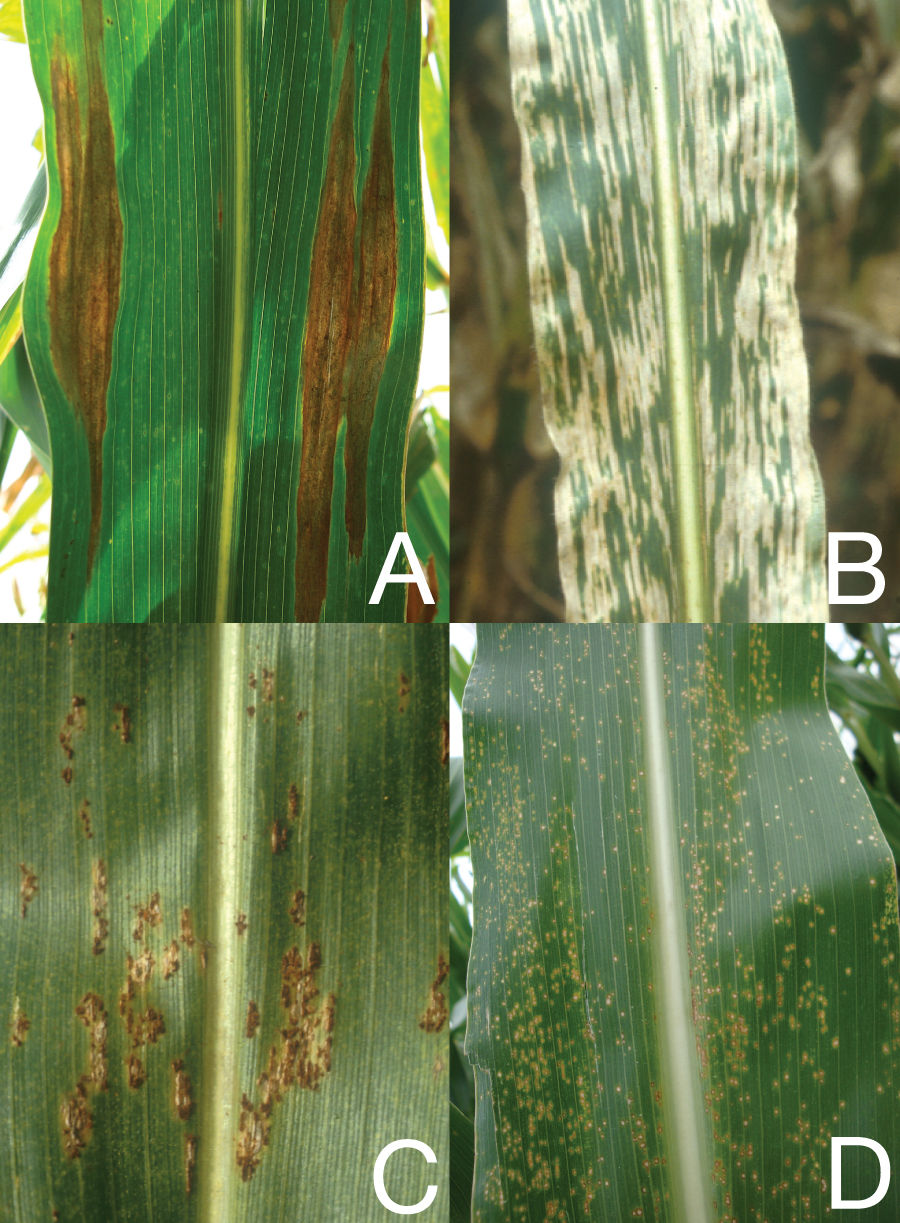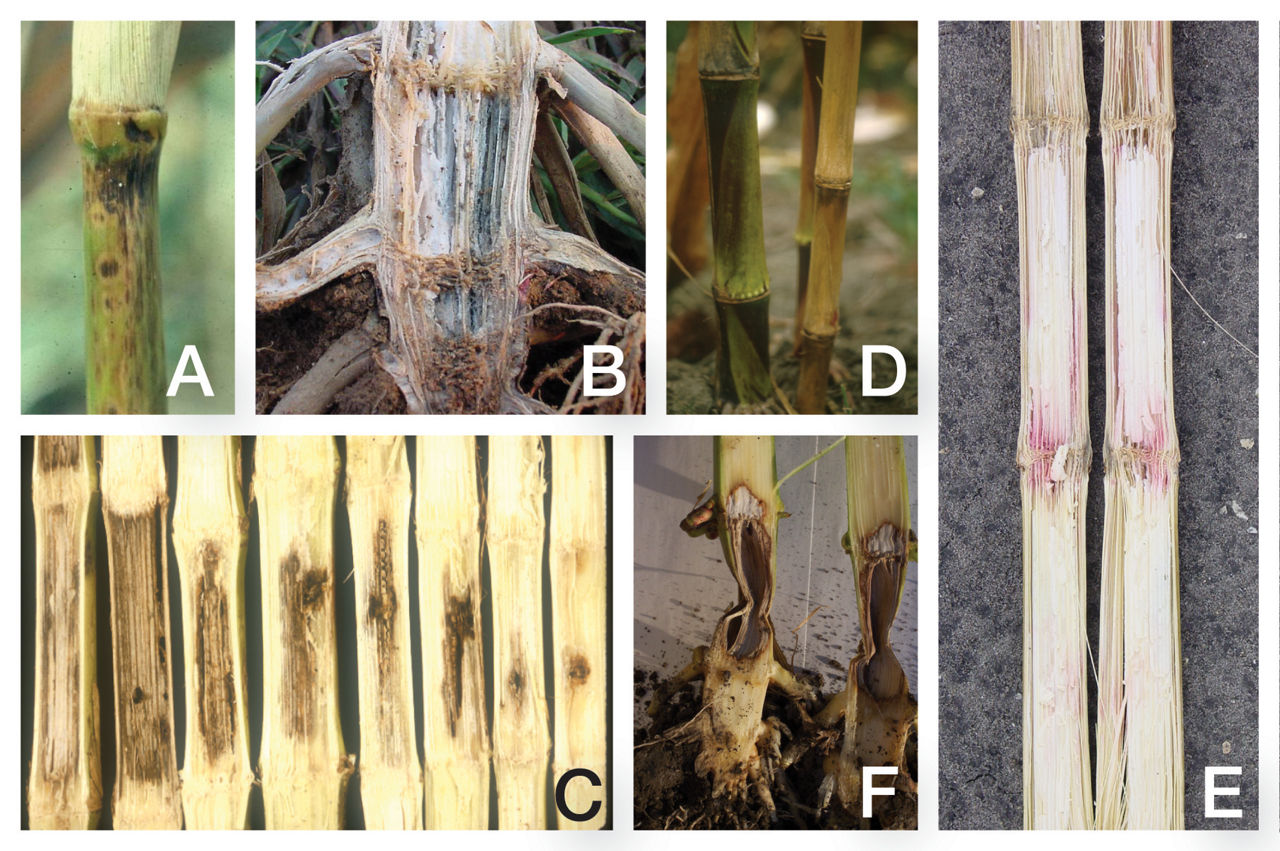How Does Corn Disease Affect Silage Quality?
July 19, 2023
The major components of corn silage as a forage are yield, or tons per acre, and quality. For dairy producers, quality refers to milk produced per ton of corn silage. For beef producers, quality is the rate of gain per ton of corn silage. Several factors can impact yield and quality, but this article will focus on the impact of various corn diseases on yield and quality of corn silage.
Corn diseases can affect the leaves, stalk, and ear. Most of these diseases are caused by fungi, though there are three bacterial diseases: Goss’s wilt, bacterial leaf streak, and bacterial stalk rot.
Many leaf diseases can infect corn plants. Some examples include northern corn leaf blight, gray leaf spot, common rust, and eye spot (Figure 1). The lesions associated with these diseases can impact the amount of photosynthetic surface area on the leaf, leading to a reduction in the amount of energy produced, which ultimately reduces grain fill. Additionally, if the infection is severe, it may result in early plant death and consequently lower kernel quality, reduced grain test weight, and a predisposition of the corn plant to root and stalk rots.

Stalk rot diseases include anthracnose stalk rot, charcoal rot, Gibberella stalk rot, Fusarium stalk rot, Diplodia stalk rot, and Pythium stalk rot (Figure 2). Stalk rots may impact harvestability, yield, moisture content, and kernel quality of the corn silage.

Ear diseases may cause the greatest concern among silage producers, as ear diseases can impact grain quality and contaminate the silage with mycotoxins. Mycotoxins are toxins produced by fungi that can pose a health risk to humans or livestock. Ear damage caused by insects that feed on husks and kernels, such as western bean cutworm or corn earworm, can increase the likelihood of mycotoxin accumulation. Common ear diseases that may produce mycotoxins include Aspergillus ear rot, Penicillium ear rot, Trichoderma ear rot, Diplodia ear rot, Fusarium ear and kernel rot, and Gibberella ear rot. Aspergillus, Fusarium, and Gibberella ear rots

How should I manage corn diseases when I am using corn for silage?
Corn products from Bayer Crop Science may have resistance or tolerance to many of the common diseases that attack corn. Using a corn product with a trait, or combination of traits, for protection from ear-attacking insects can help to reduce the potential for fungal infections. Results from studies conducted at Michigan State University from 2019 to 2021 indicate a strong correlation between insect injury and ear rot severity. The use of corn products with traits that increase resilience to ear-feeding insects can reduce mycotoxin accumulation by 75% to 90% compared to that seen in corn products with no insect-protected traits. Additionally, the data from these studies determined that fungicides did not reduce mycotoxin production that was driven by high insect pressure.10
If you are concerned about a certain disease or diseases, consult with your seed provider for an appropriate silage product for your farm that has the appropriate tolerance or resistance to the relevant disease or insect.
Other management tips include providing nutrients, irrigating, using the proper length of cut, appropriately timing the silage harvest, and—only in some cases—applying fungicide. Providing adequate plant nutrients, especially potassium (K), may help reduce the impact of the diseases. Irrigation water, where available, can also help to maintain plant health. Proper silage packing can be managed by utilizing a recommended cutting length of about .375 inches,11 and by targeting a silage moisture content of about 65% at harvest. These packing and cutting conditions can help achieve a successful ensiling process, thus potentially reducing the likelihood of mycotoxins being produced in the silage. Fungicides can be beneficial, particularly for fungal leaf diseases, but may have limited benefits for ear and stalk diseases.
When should I apply a fungicide to protect silage corn from leaf diseases?
Fungicides will have no impact on the bacterial diseases. When fungal diseases are present, research on corn grown for grain has shown the highest yield response when the fungicide is applied at VT (tasseling). While treatment thresholds are not developed for every leaf disease, some diseases have treatment guidelines. For example, Iowa State University Extension recommends a fungicide should be considered when northern corn leaf blight is found on 50% of the plants within a field, with one or more lesions per plant at tasseling.1 The University of Wisconsin recommends applying a fungicide if northern corn leaf blight lesions are present on 50% of the plants, the severity of the infection is at least 5 to 10% (5 to 10% of the leaf’s surface is covered by lesions), and the weather forecasts rainy and cool conditions.2
Protecting the upper leaves starting at the ear zone is critical, as they provide most of the energy for the developing kernels. The upper leaf canopy—from the ear to the uppermost leaf—is responsible for producing at least 60% of the photosynthate necessary for grain fill.9 While a fungicide applied to the foliage may not have a direct impact on stalk pathogens, it can indirectly impact stalk infection. Maintaining the health of a leaf prevents early plant death or cannibalization of the stalk to fill the kernels, thereby reducing the risk of subsequent root and stalk rot infection.
When should fungicide be used to treat ear diseases?
Using fungicide to protect ears from ear rot pathogens has produced inconsistent results.7,8 Research conducted by the University of Wisconsin found that the application of triazole-containing fungicide at R1 (silking) to 10 days post-silking reduced vomitoxin levels, while yield and overall silage quality were not impacted. (Vomitoxin is also known as deoxynivalenol. It is produced by the fungus Fusarium graminearum, also known as Gibberella zeae, which is the pathogen that causes Gibberella ear rot, or GER.)3 A different study found that some fungicides did reduce GER, but the results were not consistent across different corn products.3 The authors of this report did point out that a fungicide alone may not adequately reduce vomitoxin levels in years of high GER infection, and that resistant corn products may be needed.
Does a fungicide influence silage quality?
A study conducted by the University of Wisconsin found that a fungicide containing pyraclostrobin decreased leaf disease by 5% and stalk rot by 16%. Additionally, the study found a possible impact on silage quality. Neutral detergent fiber content was reduced by 1%, while starch and neutral detergent fiber digestibility increased.4
The results of a study conducted at the University of Illinois indicated that cows consuming corn silage treated with a pyraclostrobin fungicide had lower dry matter intake. However, milk production was similar to that from cows that consumed silage from untreated corn. This demonstrated that there may be higher feed conversion for cows consuming fungicide-treated corn silage.5 Further studies conducted by the University of Illinois indicated that the application of a fungicide containing pyraclostrobin to corn reduced the fiber content and increased dry matter digestibility of the silage, thus increasing the efficiency of feed conversion. Additionally, the researchers concluded that fiber content of both leaves and stalks was improved by reducing neutral detergent fiber, acid detergent fiber, and lignin content.6
Sources
1Northern corn leaf blight. Iowa State University Extension. Crop Protection Network. https://crops.extension.iastate.edu/northern-corn-leaf-blight
2Smith, D. 2018. To spray or not to spray fungicides on corn for grain or silage? University of Wisconsin Extension. https://badgercropdoc.com/2018/07/09/spray-not-spray-fungicide-corn-grain-silage/
3Smith, D.L., Mueller, B., and Goeser, J. 2018. 2018 corn silage fungicide trial results: A story of vomitoxin. University of Wisconsin Extension. https://badgercropdoc.com/2018/10/12/2018-corn-silage-fungicide-trial-results-story-vomitoxin/
4Blonde, G. and Esker, P. 2008. The effect of Headline® foliar fungicide on corn silage yield & quality. University of Wisconsin Extension. Mid-West Forage Association. http://www.midwestforage.org/pdf/274.pdf.pdf
5Haerr, K.J., Lopes, N.M., Pereira, M.N., Fellows, G.M., and Cardoso, F.C. 2015. Corn silage from corn treated with foliar fungicide and performance of Holstein cows. Journal of Dairy Science. Volume 98: 8962-8972. https://www.sciencedirect.com/science/article/pii/S0022030215007493
6Kalebich, C. and Cardoso, P. 2016. Foliar fungicide effects on corn. Forage Focus. http://www.midwestforage.org/pdf/1027.pdf.pdf
7Anderson, N.R., Romero Luna, M.P., Ravellette, J.D., and Wise, K.A. 2017. Impact of foliar fungicides on Gibberella ear rot and deoxynivalenol levels in Indiana corn. Plant Heath Progress. 18:186-191. https://apsjournals.apsnet.org/doi/10.1094/PHP-01-17-0010-RS
8Luna Romero, M.P. and Wise, K.A. 2015. Timing and efficacy of fungicide applications for Diplodia ear rot management in corn. Plant Health Progress. 16:123-131. https://apsjournals.apsnet.org/doi/abs/10.1094/PHP-RS-15-0010
9Nielsen, B. 2020. Grain fill stages in corn. Purdue University Extension. https://extension.entm.purdue.edu/newsletters/pestandcrop/article/grain-fill-stages-in-corn-3/
10Kaur, H., DiFonzo, C., Chilvers, M., Cassida, K., and Singh, M. 2023. Hybrid insect protection and fungicide application for managing ear rots and mycotoxins in silage corn. Agronomy Journal. https://acsess.onlinelibrary.wiley.com/doi/full/10.1002/agj2.21342
11Moriera, V.R. 2008. Corn silage management for lactating cows. Louisiana State University Agriculture Center. Microsoft Word - 2008-07 - CMS - Corn silage management-2picture.doc (lsuagcenter.com)
(Sources Verified 6/29/2023) 1211_144701
You may also like...
Here are some articles that may also be of interest to you